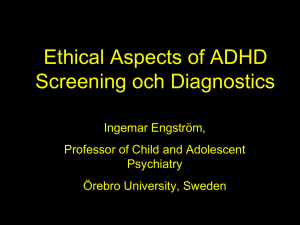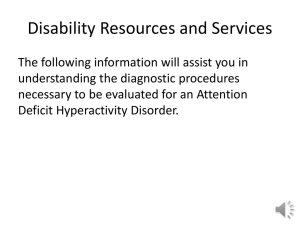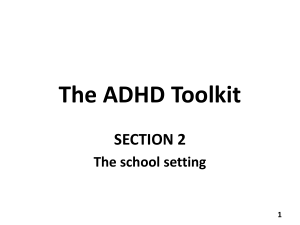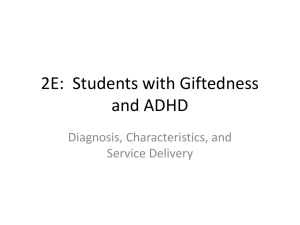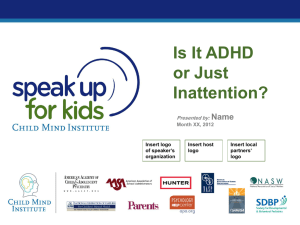ADHD Assessment and Treatment in Primary Care
advertisement
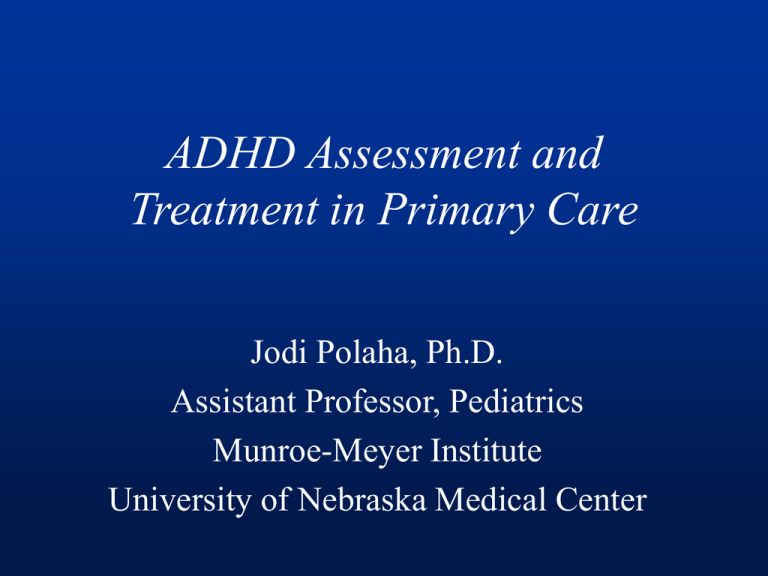
ADHD Assessment and Treatment in Primary Care Jodi Polaha, Ph.D. Assistant Professor, Pediatrics Munroe-Meyer Institute University of Nebraska Medical Center Overview • Current State of Affairs • Information and Education for Physicians • Role of Behavioral Health Specialist – Assessment – Treatment • Research Questions Current Affairs • Majority of health care visits for mental health are to primary care (60%). Current Affairs • Majority of health care visits for mental health are to primary care (60%). • “Attentional problems” greatest increase of all mental health problems in PC since 1979. Current Affairs • Majority of health care visits for mental health are to primary care (60%). • “Attentional problems” greatest increase of all mental health problems in PC since 1979. • ADHD diagnosis a 2.3-fold increase in population-adjusted rate from 1990-95. Current Affairs • Majority of health care visits for mental health are to primary care (60%). • “Attentional problems” greatest increase of all mental health problems in PC since 1979. • ADHD diagnosis a 2.3-fold increase in population-adjusted rate from 1990-95. • Children with ADHD use primary care more, cost more. Current Affairs Copeland, Wolraich, Lindgren, Milich, & Woolson, 1987 How is diagnosis made? • • • • • 79% “activity in office” 47% “neurologic soft signs” 33% “aggressive/antisocial activity” 58% parent rating scales, 62% teacher rating scales 77% stimulant response Current Affairs Copeland, Wolraich, Lindgren, Milich, & Woolson, 1987 What treatment recommendations are made? • 84% use stimulants moderately - frequently – 73% get parent report for periodic re-evaluation – 56% get teacher ratings for periodic re-evaluation – 33% treat preschoolers • 70% behavior modification • other therapies rarely recommended • 26% never refer to mental health clinics Current Affairs What treatment recommendations are made? • In pediatric visits, when meds prescribed, counseling offered in 68% cases. – Hoagwood, Jensen, Feil, Vitiello, & Bhatara, 2000 • 50% physicians surveyed referred to mental health professionals. – Jensen, Xenakis, Shervette, & Bain, 1989. • In children with ADHD under 3y.o., 57% received stimulants, but fewer psych services. – Rappley, et. al (1999) Current Affairs What treatment recommendations are made? • No indication that ADHD is overdiagnosed or that stimulant medications are overprescribed (Safer, Zito, & Fine, 1996) • Goldman et al. (1998): review of literature shows % prescribed ritalin at lower end of prevalence range. • Jensen et al. (1999): epidemiological study showed 12.5% of those meeting criteria were treated with medication in last 12 mos. Information for Physicians What information is available? • NIH Consensus Statement on ADHD • AAP Clinical Practice Guidelines – Prevalence and Assessment – Diagnosis and Evaluation – Treatment • AACAP Practice Parameters for the Assessment and Treatment of Children, Adolescents, and Adults with ADHD. Information for Physicians National Institutes of Health Consensus Statement • Developed in 1998 • 13-member panel with expertise in wide variety of disciplines. • 31 speakers all “experts” on different topics, 30 minutes to present. • Some opportunity for public debate of consensus draft. Information for Physicians National Institutes of Health Consensus Statement Pros • Points out lack of data for alternative treatments (including CBT) and support for drug and behavior therapy (p. 11). • Describes limits to medication therapy (p. 13). • Discusses difficulties of making accurate diagnosis/referral to mental health in primary care settings and why that’s a problem (p. 15). Information for Physicians National Institutes of Health Consensus Statement Cons • Long. • Non-specific and at times “says nothing.” • On the verge of being out-dated. Information for Physicians AAP Clinical Practice Guidelines • Diagnosis and Evaluation • Treatment Information for Physicians AAP Clinical Practice Guidelines Diagnosis and Evaluation 1. Kids who present with symptoms should be evaluated for ADHD (strength of evidence: good; strength of recommendation: strong). Information for Physicians AAP Clinical Practice Guidelines Diagnosis and Evaluation 1. Kids who present with symptoms should be evaluated for ADHD. 2. The diagnosis of ADHD requires that a child meet DSM-IV criteria (strength of evidence: good; strength of recommendation, strong). Information for Physicians AAP Clinical Practice Guidelines Diagnosis and Evaluation 1. Kids who present with symptoms should be evaluated for ADHD. 2. The diagnosis of ADHD requires that a child meet DSM-IV criteria. 3. Assessment requires direct evidence from parents regarding core symptoms, duration, and degree of impairment (evidence: good; recommendation, strong). Information for Physicians AAP Clinical Practice Guidelines Diagnosis and Evaluation 1. Kids who present with symptoms should be evaluated for ADHD. 2. The diagnosis of ADHD requires that a child meet DSM-IV criteria. 3. Assessment requires direct evidence from parents regarding core symptoms, duration, and degree of impairment. 4. Assessment requires direct evidence from teachers as above plus a review of school records (evidence: good, recommendation: strong). Information for Physicians AAP Clinical Practice Guidelines Diagnosis and Evaluation 1. Kids who present with symptoms should be evaluated for ADHD. 2. The diagnosis of ADHD requires that a child meet DSM-IV criteria. 3. Assessment requires direct evidence from parents regarding core symptoms, duration, and degree of impairment. 4. Assessment requires direct evidence from teachers as above plus a review of school records. 5. Assess for coexisting conditions (evidence: strong, recommendation: strong). Information for Physicians AAP Clinical Practice Guidelines Diagnosis and Evaluation 1. Kids who present with symptoms should be evaluated for ADHD. 2. The diagnosis of ADHD requires that a child meet DSM-IV criteria. 3. Assessment requires direct evidence from parents regarding core symptoms, duration, and degree of impairment. 4. Assessment requires direct evidence from teachers as above plus a review of school records. 5. Assess for coexisting conditions. 6. Other diagnostic tests not indicated to establish diagnosis (evidence: strong, recommendation: strong). Information for Physicians AAP Clinical Practice Guidelines Treatment 1. Establish management program recognizing ADHD as chronic condition (evidence: good; recommendation, strong). Information for Physicians AAP Clinical Practice Guidelines Treatment 1. Establish management program recognizing ADHD as chronic condition. 2. Treating clinician, parents, child and school should specify appropriate target outcomes to guide treatment (evidence: good; recommendation: strong). Information for Physicians AAP Clinical Practice Guidelines Treatment 1. Establish management program recognizing ADHD as chronic condition. 2. Treating clinician, parents, child and school should specify appropriate target outcomes to guide treatment. 3. Clinician should recommend medication (evidence: good) and /or behavior therapy (evidence: fair) to improve outcomes (recommendation: strong). Information for Physicians AAP Clinical Practice Guidelines Treatment 1. Establish management program recognizing ADHD as chronic condition. 2. Treating clinician, parents, child and school should specify appropriate target outcomes to guide treatment. 3. Clinician should recommend medication and /or behavior therapy to improve outcomes. 4. When outcome has not met targeted goal, clinician should re-evaluate diagnosis, treatments, adherence,and coexisting problems (evidence: weak; recommendation: strong). Information for Physicians AAP Clinical Practice Guidelines Treatment 1. Establish management program recognizing ADHD as chronic condition. 2. Treating clinician, parents, child and school should specify appropriate target outcomes to guide treatment. 3. Clinician should recommend medication and /or behavior therapy to improve outcomes. 4. When outcome has not met targeted goal, clinician should re-evaluate diagnosis, treatments, adherence,and coexisting problems. 5. Clinician should systematically follow-up with parents, teacher and child (evidence: fair; recommendation, strong). Role of Behavioral Health Specialist: Assessment • Educate. • Familiarize with norm-referenced, empirically-supported rating scales and encourage use. • Take on ADHD assessment cases, OR, set up protocol for practice. • Provide consultative assistance. Role of Behavioral Health Specialist: Assessment: The BHC Protocol Parent Ratings • BASC • Conners • ADHD-IV/DBD Checklist • Measure of adaptive functioning • ECBI Teacher Ratings • BASC • Conners • ADHD-IV/DBD Checklist • Measure of adaptive functioning Role of Behavioral Health Specialist: Assessment: The BHC Protocol • Clinical interview. • School records. Role of Behavioral Health Specialist: Treatment • In-house behavioral interventions with family. • School-based consultation and behavioral intervention development. • Assessment of progress toward goals including response to drug therapy and behavioral interventions. Research Questions: Assessment • What are actual current practices? How are they in line with AAP Guidelines? • Can a protocol be developed for assessment of ADHD in primary care that is effective but efficient? How does it improve accuracy of diagnoses? • What is the smallest protocol that can be used? Research Questions: Treatment • What are actual current practices? How are they in line with AAP Guidelines? • What is the best, most practical way of providing feedback re: medication effectiveness for titration? • How does in-house behavioral services and collaboration with schools improve care?

